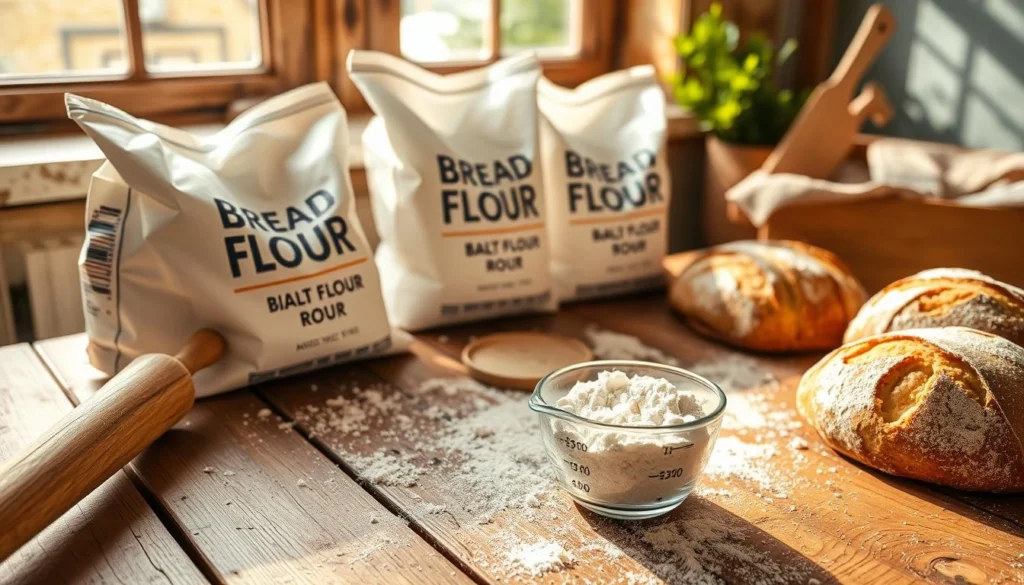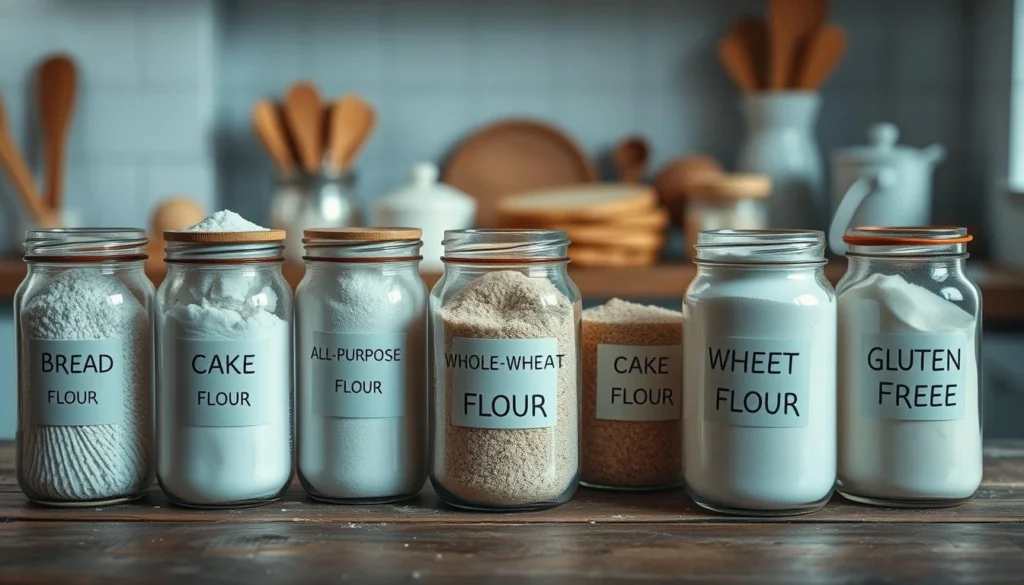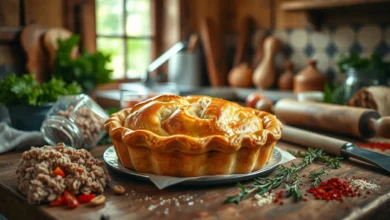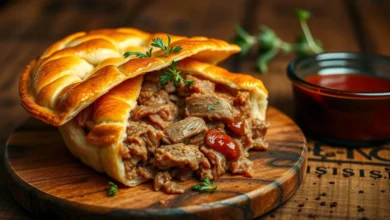Best Flour Bread Flour for Perfect Homemade Baking

If you love baking homemade bread, you know flour matters a lot. Bread flour is key for making delicious, well-shaped breads. It makes the bread rise well and gives it a nice chew. We’ll explore bread flour’s special traits, top brands, and how to use it in your baking.
Understanding Bread Flour Basics and Its Unique Properties
Bread flour is a game-changer in baking. It’s different from all-purpose flour because it has more protein. This extra protein is key for the perfect rise and texture in homemade breads.
Protein Content and Gluten Development
Bread flour has 12-14% protein, while all-purpose flour has 10-12%. The higher protein in bread flour helps create a strong gluten network. This network is essential for the texture and rise of your baked goods.
When you knead the dough, the proteins form long, elastic strands of gluten. This gluten is what makes bread chewy and allows it to rise high. Bread flour’s gluten structure is unmatched by all-purpose flour.
Comparing Bread Flour to All-Purpose Flour
- Bread flour: Higher protein content (12-14%) for superior gluten development
- All-purpose flour: Lower protein content (10-12%) for a more delicate texture
The Science Behind Strong Flour
The strength of bread flour comes from the wheat varieties used. Hard red winter wheat is chosen for its high protein and gluten-forming abilities. The milling process also makes bread flour finer, leading to a more even texture.
“Bread flour is the cornerstone of any serious home baker’s pantry. Its superior gluten development is the key to achieving the perfect rise and texture in your homemade breads.”

What Makes Flour Bread Flour Different from Other Types
Not all flours are the same when it comes to baking. Bread flour is special because it makes homemade bread light, airy, and perfectly shaped. Let’s see what makes it different.
Bread flour has more protein, about 12-14%. This means it forms more gluten. Gluten is key for bread’s strong structure and chewy texture. All-purpose flour, with less protein, is better for cakes and pastries.
The way bread flour is milled also makes it unique. It comes from harder wheat, like hard red winter wheat. This gives it a coarser texture and larger proteins. These traits help it soak up more liquid and create a robust dough, perfect for homemade bread.

If you want to bake the best homemade bread, use bread flour. Its special qualities are essential for a tender crumb and a satisfying chew. It’s a must-have for any bread baker.
Top-Rated Bread Flour Brands for Home Baking
Choosing the right bread flour is key to making delicious homemade bread. There are many high-quality options available. These range from premium artisanal brands to budget-friendly and organic choices.
Premium Artisanal Bread Flour Brands
Premium artisanal bread flour brands offer the best baking performance. They use special wheat cultivars for better gluten development and texture. King Arthur Flour and Bob’s Red Mill are top choices for both pros and home bakers.
Budget-Friendly Bread Flour Options
Even on a budget, you don’t have to sacrifice quality. Brands like Gold Medal and Pillsbury offer great bread flour at lower prices. These options can still make your homemade breads amazing without costing too much.
Organic Bread Flour Selections
Health-conscious bakers will love organic bread flour. Brands like Arrowhead Mills and Hodgson Mill provide organic options. These flours are free from additives and preservatives, making them perfect for those who prefer natural ingredients.
Finding the best bread flour brands for you depends on your preferences and budget. Trying different high-quality flours can help you find the perfect one for delicious homemade breads.
Selecting the Right Bread Flour for Different Baking Projects
Choosing the right bread flour is key to making great homemade bread. It affects the texture, rise, and quality of your baked goods. Knowing the unique qualities of bread flour is important for perfect results.
Bread flour has a high protein content, between 12% to 14% or more. This high protein means it has a strong gluten structure. This is crucial for yeast-based breads to rise well and have a chewy texture. But, not all bread flour is the same, and your baking project might need something specific.
Matching Bread Flour to Your Baking Projects
When picking the right bread flour, think about these factors:
- Protein Content: For crusty breads, choose a bread flour with 14% protein. For lighter baked goods, go for 12% protein.
- Gluten Strength: For soft breads, pick a bread flour with moderate gluten. For chewy loaves, choose stronger gluten.
- Absorption Rate: The absorption rate shows how much liquid the flour can handle. Match it to your recipe for the best results.
By choosing the right bread flour, you can make your homemade breads, rolls, and treats even better.
“The right bread flour can be the difference between a mediocre loaf and a bakery-worthy masterpiece.”
Storage Tips to Maintain Bread Flour Freshness
Keeping your bread flour fresh is key for great baking. Whether you bake often or just stock up, knowing how to store bread flour is important. It helps keep your flour in top shape for all your baking.
Proper Container Selection
Choosing the right container is vital for storing bread flour. Use an airtight, moisture-proof container like a sealed plastic or glass jar. This keeps your flour from getting damp and clumpy. Don’t store it in the original paper bag, as it lets air in and can get contaminated.
Temperature and Humidity Control
Keeping the right temperature and humidity is key for flour freshness. The best place is cool, dry, and dark. Store your flour at a steady 60°F to 70°F, with humidity under 60%. Too much heat or moisture can spoil the flour, affecting its taste and performance.
Shelf Life Guidelines
- Unopened, stored properly: up to 1 year
- Opened, stored properly: up to 6 months
- Stored in the freezer: up to 2 years
Watch the shelf life of your bread flour and use the oldest first. Always check the expiration date and use the oldest flour to bake with the freshest ingredients.
“Proper bread flour storage is the key to consistently excellent baking results.”
Common Mistakes When Using Bread Flour
Baking with bread flour can make your homemade breads perfect. But, it comes with its own set of challenges. To avoid bread flour mistakes and baking errors, follow these tips for flawless recipes every time.
- Improper Measuring: Bread flour is denser than all-purpose flour. Using cups can lead to too much. Always weigh your bread flour for the best results.
- Overworking the Dough: Bread flour’s high protein content means it develops gluten quickly. Overworking can make the dough tough. Be gentle and knead only until it’s smooth and elastic.
- Using the Wrong Flour: Not all recipes are for bread flour. Swapping it for all-purpose flour can make the bread dense and dry. Always use the flour called for in the recipe.
By avoiding these bread flour mistakes and baking errors, you’ll bake light, airy loaves with the perfect chew. Mastering bread flour is key to improving your homemade baked goods.
“Baking is a science, and using the right flour is crucial for achieving the desired results.”
Measuring Techniques for Perfect Bread Flour Ratios
Getting consistent baking results starts with accurate flour measurement. Whether you’re an experienced baker or new to the kitchen, learning to measure flour well is key. We’ll look at the difference between weight and volume measurements and share tips from professional bakers to help you improve.
Weight vs. Volume Measurements
For flour, weight is the best way to measure accurately. Unlike volume, which can change based on how the flour is packed, weight gives a consistent measurement. Professional bakers use digital scales because even a small mistake in flour can affect your baking.
Professional Baker’s Tips
- Use a digital scale to measure flour by weight, rather than relying on volume measurements like cups or spoons.
- Fluff the flour before measuring to avoid packing it down, which can lead to using too much.
- Sift the flour if the recipe calls for it, as this can impact the overall flour-to-liquid ratio.
- Invest in a reliable set of measuring cups and spoons to ensure consistent volume measurements when necessary.
- Familiarize yourself with standard flour-to-liquid ratios for different baking projects, such as flour measuring techniques and baking ratios.
By following these tips and focusing on precise flour measurement, you’ll get better at baking. Mastering flour measurement is the first step to baking success. So, take the time to get these techniques right and enjoy the fruits of your labor.
Substituting Other Flours When You’re Out of Bread Flour
Don’t worry if you’re out of bread flour. There are many flour substitutes and bread flour alternatives to help you bake. Learning to swap these ingredients can change your baking game. It lets you keep making tasty homemade breads.
Here are some top flour substitutes for when you’re out of bread flour:
- All-Purpose Flour: Use it as a 1:1 substitute for bread flour. Your bread might be denser and less chewy.
- Whole Wheat Flour: It has more protein, making it a good choice. Mix 75% bread flour with 25% whole wheat for the best results.
- Rye Flour: It adds a special flavor and texture. Use it with all-purpose flour in a 50/50 ratio.
- Spelt Flour: An ancient grain that can replace bread flour 1:1. It gives a nutty and complex taste.
Using these bread flour alternatives might require some tweaks. You might need to add more liquid or knead longer. This helps get the right texture and rise. Start with small batches to find the perfect mix for your baking.
| Flour Substitute | Ratio to Bread Flour | Key Characteristics |
|---|---|---|
| All-Purpose Flour | 1:1 | Slightly denser and less chewy |
| Whole Wheat Flour | 75% Bread Flour, 25% Whole Wheat | Higher protein content, heartier texture |
| Rye Flour | 50% Bread Flour, 50% Rye Flour | Unique flavor and texture |
| Spelt Flour | 1:1 | Nutty and complex flavor |
Trying out different flour substitutes and bread flour alternatives can lead to new tastes and textures. It’s a chance to explore and find the perfect flour for your needs.
Troubleshooting Common Bread Flour Issues
Getting the perfect texture, rise, and flavor in homemade bread is tricky with bread flour. But, with some troubleshooting, you can fix common problems. This way, you’ll always make great bread. Let’s look at how to solve texture, rising, and flavor issues.
Texture Problems
If your bread is too dense or tough, it might be from over-kneading or too much flour. Try kneading less and measuring flour more gently. If it’s too airy and crumbly, add more flour or knead longer to strengthen the dough.
Rising Concerns
When your bread doesn’t rise well, it’s a big problem. Check if your yeast is fresh and active. Make sure the rising area is warm and draft-free. If it’s not rising, try longer proofing or more yeast.
Flavor Adjustments
Bread flour’s strong flavor can overwhelm other ingredients. To balance it, use less bread flour or mix in all-purpose flour. Try different yeast types, add herbs, or ferment longer to improve your bread’s taste.
FAQ
What is bread flour and how does it differ from all-purpose flour?
Bread flour has more protein than all-purpose flour. This makes it better for gluten development. As a result, breads made with it are chewier and have a better structure.
Why is the protein content important in bread flour?
Protein content in bread flour is key for gluten development. Gluten is what makes bread elastic and gives it structure. More protein means better gluten, leading to higher rising and better texture.
What are the unique properties of bread flour that make it different from other flour types?
Bread flour comes from hard wheat, unlike all-purpose flour. It has 12-14% protein, which helps in gluten formation. This results in a chewier crumb. It also absorbs more liquid, making dough less sticky.
What are some top-rated bread flour brands for home baking?
Top brands for home baking include King Arthur Flour, Bob’s Red Mill, Antimo Caputo, and Guisto’s Vita-Grain. They offer high-quality flours. Each brand has different protein content and milling processes.
How do I choose the right bread flour for different baking projects?
Choose bread flour based on your recipe and desired texture. For chewier breads like bagels, use high-protein flour. For lighter breads, use lower-protein flour. Adjust protein content for the best results.
How should I store bread flour to maintain its freshness?
Store bread flour in an airtight container at room temperature. Keep it away from sunlight and heat. Don’t refrigerate or freeze it. Use it within 6-12 months for best quality.
What are some common mistakes to avoid when using bread flour?
Avoid overworking dough to prevent toughness. Use the right amount of flour to avoid dryness or stickiness. Proper hydration is crucial for texture and rise. Follow recipe instructions carefully.
How do I accurately measure bread flour for recipes?
Use a kitchen scale for accurate measurements. Measure by weight, not volume. If using cups, gently spoon flour and level it off to avoid excess.
What can I use as a substitute for bread flour if I don’t have it on hand?
Mix all-purpose flour with vital wheat gluten as a substitute. This mimics bread flour’s protein and gluten properties. High-protein all-purpose flour, like King Arthur’s, is also a good option.
How can I troubleshoot common issues when using bread flour?
For texture issues, adjust dough hydration. For rising problems, check yeast activity and proofing conditions. For flavor, try different bread flour brands or blends.



